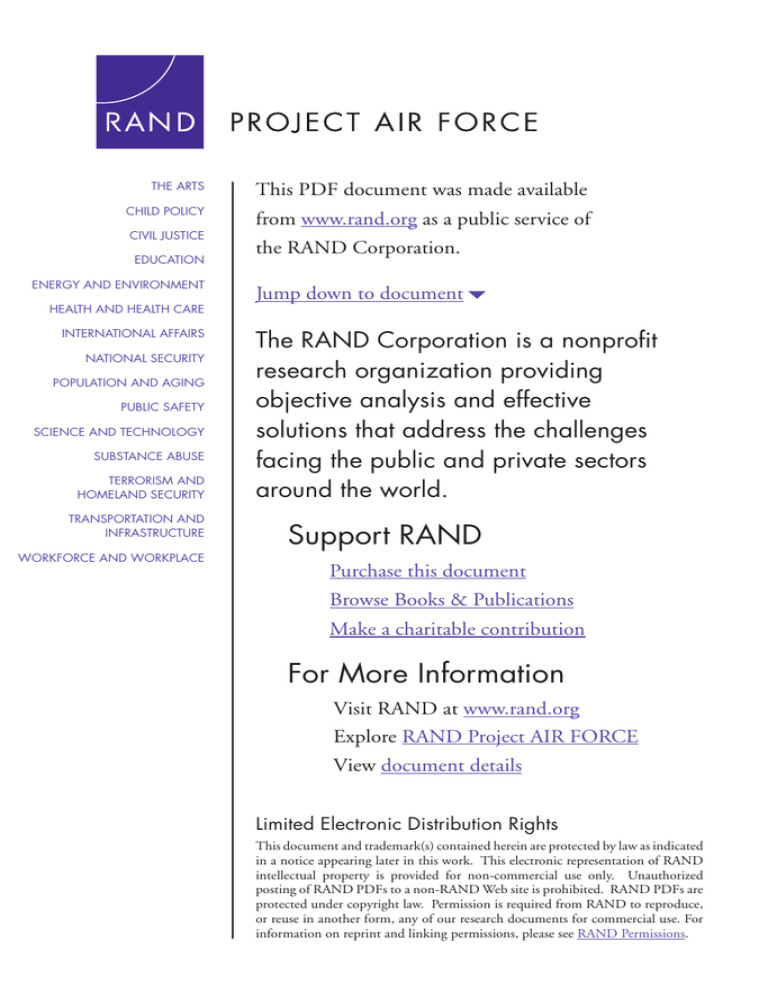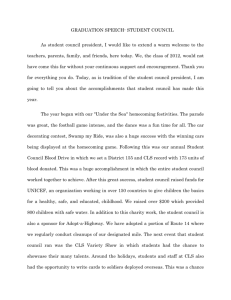
THE ARTS
This PDF document was made available
CHILD POLICY
from www.rand.org as a public service of
CIVIL JUSTICE
EDUCATION
ENERGY AND ENVIRONMENT
HEALTH AND HEALTH CARE
INTERNATIONAL AFFAIRS
NATIONAL SECURITY
POPULATION AND AGING
PUBLIC SAFETY
SCIENCE AND TECHNOLOGY
SUBSTANCE ABUSE
TERRORISM AND
HOMELAND SECURITY
TRANSPORTATION AND
INFRASTRUCTURE
WORKFORCE AND WORKPLACE
the RAND Corporation.
Jump down to document6
The RAND Corporation is a nonprofit
research organization providing
objective analysis and effective
solutions that address the challenges
facing the public and private sectors
around the world.
Support RAND
Purchase this document
Browse Books & Publications
Make a charitable contribution
For More Information
Visit RAND at www.rand.org
Explore RAND Project AIR FORCE
View document details
Limited Electronic Distribution Rights
This document and trademark(s) contained herein are protected by law as indicated
in a notice appearing later in this work. This electronic representation of RAND
intellectual property is provided for non-commercial use only. Unauthorized
posting of RAND PDFs to a non-RAND Web site is prohibited. RAND PDFs are
protected under copyright law. Permission is required from RAND to reproduce,
or reuse in another form, any of our research documents for commercial use. For
information on reprint and linking permissions, please see RAND Permissions.
This product is part of the RAND Corporation monograph series.
RAND monographs present major research findings that address the
challenges facing the public and private sectors. All RAND monographs undergo rigorous peer review to ensure high standards for
research quality and objectivity.
Contractor Logistics
Support in the
U.S. Air Force
Michael Boito, Cynthia R. Cook, John C. Graser
Prepared for the United States Air Force
Approved for public release; distribution unlimited
P R O J ECT A I R FORCE
The research described in this report was sponsored by the United States
Air Force under Contract FA7014-06-C-0001. Further information may
be obtained from the Strategic Planning Division, Directorate of Plans,
Hq USAF.
Library of Congress Cataloging-in-Publication Data
Boito, Michael, 1957–
Contractor logistics support in the U.S. Air Force / Michael Boito,
Cynthia R. Cook, John C. Graser.
p. cm.
Includes bibliographical references.
ISBN 978-0-8330-4576-8 (pbk. : alk. paper)
1. United States. Air Force—Weapons systems—Maintenance and repair.
2. United States. Air Force—Weapons systems—Maintenance and repair—Costs.
3. Logistics—Contracting out—United States. I. Cook, Cynthia R., 1965–
II. Graser, John C. III. Title.
UG1103.B656 2009
358.4'1411—dc22
2009006827
The RAND Corporation is a nonprofit research organization providing
objective analysis and effective solutions that address the challenges
facing the public and private sectors around the world. R AND’s
publications do not necessarily reflect the opinions of its research clients
and sponsors.
R® is a registered trademark.
© Copyright 2009 RAND Corporation
All rights reserved. No part of this book may be reproduced in any
form by any electronic or mechanical means (including photocopying,
recording, or information storage and retrieval) without permission in
writing from RAND.
Published 2009 by the RAND Corporation
1776 Main Street, P.O. Box 2138, Santa Monica, CA 90407-2138
1200 South Hayes Street, Arlington, VA 22202-5050
4570 Fifth Avenue, Suite 600, Pittsburgh, PA 15213-2665
RAND URL: http://www.rand.org
To order RAND documents or to obtain additional information, contact
Distribution Services: Telephone: (310) 451-7002;
Fax: (310) 451-6915; Email: order@rand.org
Summary
The Air Force devotes enormous resources to operating and maintaining its weapon systems. In fiscal year (FY) 2006, the Air Force
spent almost $36 billion on weapon system O&S, measured in constant FY 2004 dollars.1 The Air Force has a range of choices when considering how best to sustain weapon systems and components. It can
do the work in-house using organic facilities, it can pay contractors to
do the work (subject to some congressionally imposed limits), or it can
engage in a mix of the two approaches.2
This monograph addresses CLS, which is defined as contractor
sustainment of a weapon system that is intended to cover the total life
cycle of the weapon system and generally includes multiple sustainment elements. CLS does not include interim contractor support, a
temporary measure for a system’s initial period of operation before a
permanent form of support is in place. CLS also excludes contractor
sustainment support for a specific sustainment task that the Air Force
would otherwise conduct itself; a typical example would be a weapon
system’s prime contractor providing sustaining engineering.3
1
O&S includes all costs of operating, maintaining, and supporting a fielded system,
including costs for personnel; consumable and repairable items; organizational, intermediate, and depot maintenance; facilities; and sustaining investment. Data from an Air Force
Total Ownership Cost management information system query in January 2007.
2
Federal laws require that government facilities conduct at least one-half of all depot maintenance work and that the government retain certain core maintenance capabilities. Chapter
Two discusses this and provides specific references.
3
In practice, there is some overlap among the various kinds of contract support. The Air
Force identifies and funds the varieties of contract sustainment support using element-of-
xiii
xiv
Contractor Logistics Support in the U.S. Air Force
The Air Force has increasingly chosen CLS as an alternative to
organic support of weapon systems over the last several years. The Air
Force increased its use of CLS by more than 150 percent in constant
dollars from FY 2000 to FY 2006, a rate far greater than the 30 percent
increase in spending on weapon system O&S over the same period.
Despite the Air Force’s increased use of CLS, several of the unanswered questions about its management and use might be of interest to
decisionmakers. We examine these questions, and when appropriate,
provide recommendations for more effective use of CLS:
• What is driving the growth of CLS in the Air Force?
• How has contractor performance under CLS compared to initial
estimates of cost and performance?
• What are the key cost drivers for CLS?
• How are the prices for CLS contracts determined?
• Do weapon systems have characteristics that are associated with
using CLS; if so, what are they?
• How does the Air Force manage its compliance with laws governing the use of CLS?
• Does using CLS have disadvantages?
• What does using CLS imply for O&S cost estimating?
We approached these questions in four ways. First, we reviewed
the laws, regulations, and instructions that govern the use of CLS in
DoD and especially in the Air Force. This helped us understand limits
and requirements that Congress and DoD have imposed on the Air
Force for the use of CLS, as well as the official implementation of policies and procedures. We also reviewed reports from the Government
Accountability Office (GAO) and DoD Inspector General, which were
helpful in understanding problems and issues with the use of CLS over
time.
expense investment codes (EEICs) in its financial system. EEIC 578 is intended to capture
CLS. We have used funds coded as EEIC 578 to identify CLS in this study. Chapter Three
describes this coding more completely. Air Force Instruction (AFI) 63-111 dated October 21,
2005 defines the kinds of contract support.
Summary xv
Second, we examined the Air Force Total Ownership Cost management information system to understand the magnitude of CLS use
and cost trends for the Air Force as a whole, by type of system, and by
individual program.
Third, because the Air Force does not require detailed or uniform
financial reporting of CLS costs in a corporatewide financial system,
we obtained CLS brochures for individual programs to gain greater
insight into the nature of CLS. Programs that do use CLS prepare
these brochures annually. Each brochure contains a narrative describing the support provided and its cost by task. These brochures allowed
us to address questions about key CLS cost drivers—specifically, about
the kinds of tasks for which CLS is used.
Fourth, we spoke with a wide variety of people knowledgeable
about the use of CLS. We held discussions with representatives of
roughly a dozen large programs that use CLS. We also interviewed
personnel experienced in logistics, contracting, and CLS financial and
program management. These people worked at Air Force operational
commands and Air Force Materiel Command, Headquarters U.S. Air
Force (HQ USAF), the Office of the Secretary of Defense, the GAO,
and the weapon system contractors that provide CLS.
This combination of approaches allowed us to address most of
the research questions satisfactorily. Some issues regarding CLS performance remained unresolved, as we will discuss.
We found that 86 percent of the Air Force’s CLS spending is on
aircraft systems, with the remainder on space, missile, munitions, and
other kinds of systems. (See p. 22.) Most of the growth in CLS spending in this decade has been in aircraft systems, with the C-17 and F-22
programs increasing the most because more aircraft are being delivered
and because both programs recently transitioned from interim contract
support to CLS. We found no evidence that the costs of ongoing and
long-term CLS contracts are increasing at a faster rate than comparable
organically supported programs. Rather, the increase in CLS spending
is due mostly to decisions to support most new aircraft systems with
CLS, while the legacy systems that they replace tend to be supported
organically. (See pp. 24–29.)
xvi
Contractor Logistics Support in the U.S. Air Force
We were unable to determine how CLS had performed relative
to initial estimates because we found that initial estimates generally
either were not developed or were not documented and retained. (See
pp. 40–41.)
The key cost drivers for CLS on aircraft programs are depot maintenance for airframes and engines and the repair and replacement of
parts. (See pp. 31–32.) Aircraft CLS programs have a wide scope of
tasks, so contractors on some programs provide a substantial number
of field-support representatives, or technicians, who perform maintenance at the flight line. Contractors on other programs provide much
of the sustaining engineering. On practically all, if not all, aircraft CLS
programs, contractors provided supply-chain management. (See pp.
20–21, 31–32, 93.)
We found that CLS prices for major weapon systems are seldom
determined by competition. Exceptions to this norm are typically for
commercial-derivative products. (See p. 72.) Prices depend on the type
of contract. CLS contracts use a variety of contract vehicles and types.
For cost-type contracts or tasks, the contractor is reimbursed for costs
incurred plus a fee. For fixed-price contracts or tasks, government personnel generally examine the number of labor hours and the material costs the contractor has proposed to determine whether both are
reasonable. The price is determined by the negotiated labor hours, the
contractor’s hourly labor rate(s), expected material usage and cost, plus
a fee (profit). (See pp. 72–74.)
CLS contracts often guarantee a large amount of funding to the
contractor in each fiscal year. This limits the flexibility of the Air Force
to reduce funding levels without violating the terms of the contract.
(See pp. 68–69.)
Competition is often impossible because the government lacks
the technical data or the data rights needed to allow third parties to
maintain the equipment, so only the original equipment manufacturer,
which has the technical data, can do the maintenance. (See p. 58.)
We found that the availability of CLS cost and performance data
varied among individual program offices. (See pp. 69–74.)
Several weapon-system characteristics were associated with the
use of CLS, including programs that were commercial derivatives, were
Summary xvii
highly classified, were complex, had a small fleet, or had started as
advanced concept technology demonstrations. Two additional conditions associated with the use of CLS, although not with characteristics
of the weapon systems, were a lack of data rights and the decision of a
senior Air Force official. (See pp. 57–65.)
Certain limitations affected our ability to address all the issues
satisfactorily. The most serious is the lack of detailed cost and performance data on CLS contracts, which limits our ability to assess the
cost and performance of CLS relative to initial estimates or government performance of comparable work. The lack of detailed cost and
performance data on CLS contracts also severely limited our ability to
provide improved tools or guidance to cost estimators.
Also note that we did not specifically address issues associated
with the use of performance-based logistics or public-private partnerships, which are sustainment approaches DoD has emphasized for the
last several years.
The final chapter discusses five changes that should improve the
Air Force’s ability to use CLS effectively. The Air Force is in the process
of implementing some of the changes:
1. To preserve the option of sustainment by organizations other
than the contractors that manufactured the equipment, the Air
Force should require centralized decisions on buying design and
technical data or usage rights to such data. (See pp. 83–85.)
2. To facilitate future analysis and estimation of O&S costs, the
Air Force should require collection of CLS cost data in a standardized format, as specified by the Office of the Secretary of
Defense Cost Analysis Improvement Group, and should retain
the data centrally. (See pp. 85–87.)
3. To ensure that the corporate Air Force has the flexibility to
adjust funding levels for all aircraft sustainment programs, the
Air Force should provide centralized guidance to achieve flexibility in CLS contracts. (See pp. 87–88.)
4. To improve its ability to manage CLS across the enterprise, the
Air Force should strengthen data collection and analysis and
expertise and make the data and expertise available to pro-
xviii
Contractor Logistics Support in the U.S. Air Force
gram office personnel. This could be done by centralizing and
strengthening an organization with logistics responsibilities
and/or by strengthening a career field, such as acquisition logisticians. (See pp. 88–91.)
5. The Air Force should strive to retain choices for logistics services
over the life cycle of the weapon system. The first four changes
support this goal. (See pp. 91–92.)




